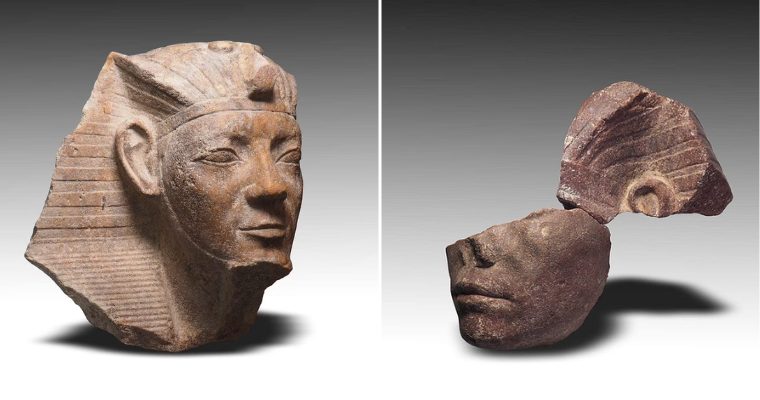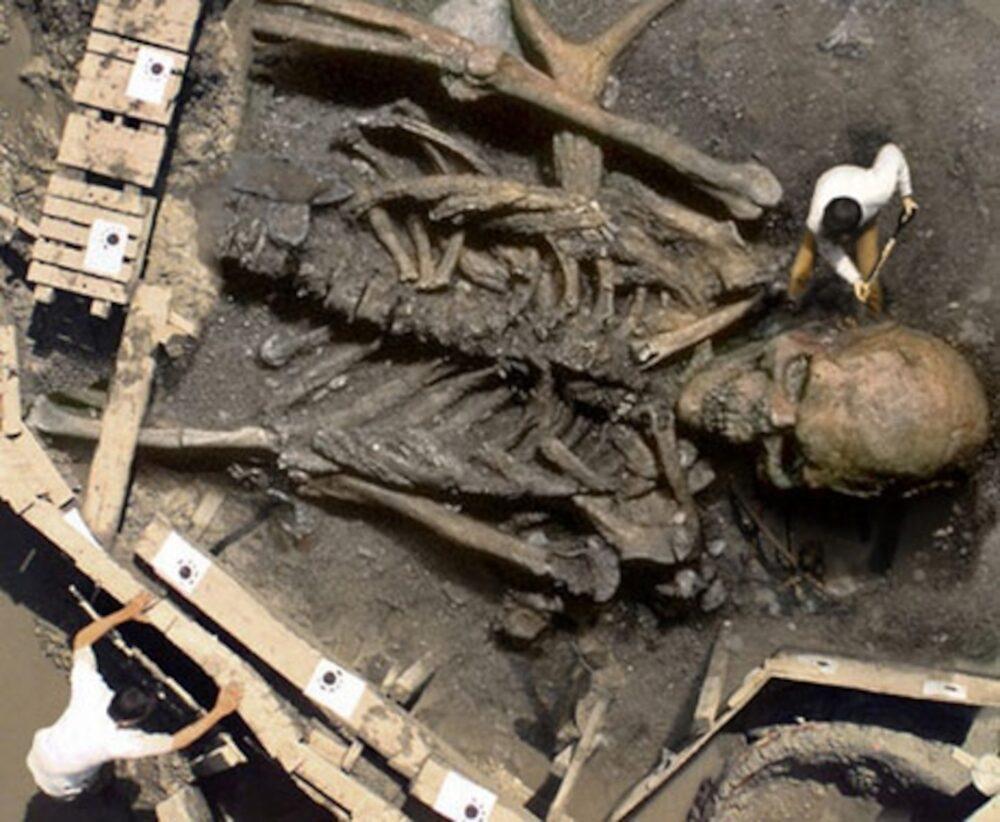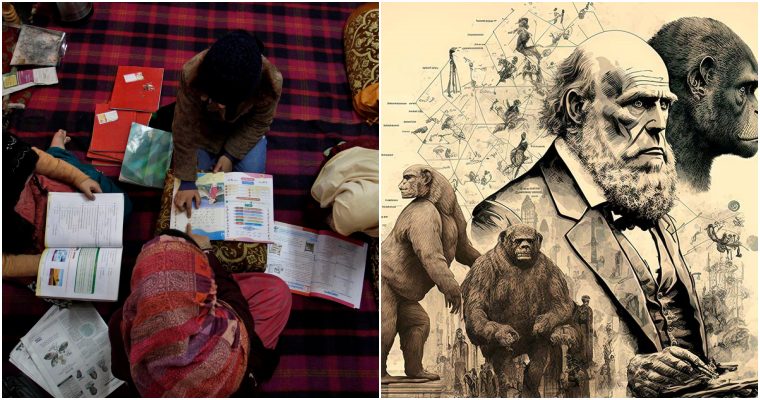Sometimes people just need to let their hair down. Whether you’re a despotic ruler seeking to distract from a major controversy or a downtrodden peasant looking to get away from the daily grind, nothing else distracts like a good party. It should come as no surprise that humans have been partying for thousands of years. Here’s a list of what people got up to at eight of history’s most legendary parties of all time.
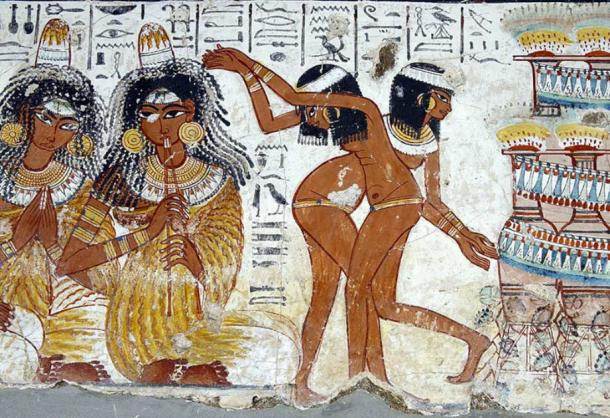
Representational image of a historic party, with musicians and dancers living it up on a fresco from the tomb of Nebamun. ( Public domain )
Legendary Party #1. Egypt’s Festival of Drunkenness
These days, religion tends to have a bit of a stuffy image. Some religions ban the consumption of alcohol outright and those that don’t tend to take a dim view of overindulgence. This wasn’t always the case. The worshippers of ancient times really knew how to party.
The Festival of Drunkenness dates back to the 15th century BC and was an important religious celebration. According to Egyptian mythology, the sun god Ra prevented mankind’s destruction using alcohol. Hathor, another Egyptian god, was planning to devour all human life on earth but Ra stopped her by tricking her into drinking 7,000 jars of beer dyed red to look like blood.
As anyone who has ever drunk one too many beers will know, plans have a habit of going out of the window when the buzz kicks in. This was definitely true for Hathor, who promptly passed out and forgot all about her world-ending plans.
To celebrate this event, the Egyptians gathered on the 20th day of Toth every year and consumed vast amounts of alcohol. The aim was to copy Hathor and pass out. Since Hathor was also the goddess of love and fertility many Egyptians also saw this as a great chance to carry out orgies and sex parties in her name. All Hail Hathor!
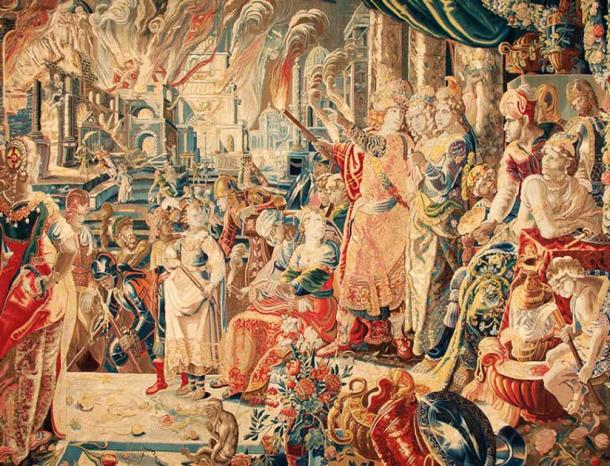
A tapestry depicting the fire of Persepolis from the History of Alexander the Great series by Karel van Mander. ( Public domain )
Legendary Party #2. Alexander the Great and the Burning of Persepolis
Some of the greatest parties in history have been held to celebrate a major victory. Alexander the Great’s party at Persepolis is a prime example of what happens when one of these parties gets a little out of hand. A cross between a party and a purge, this party culminated in murder, rape, and a general level of drunkenness that was pretty much unheard of. Persepolis was left looted and its grand Royal Palace was torched to a crisp.
While the party itself happened in 331 BC, we must look back to 480 BC for an explanation as to why the party got so out of hand. In 480 BC the great city of Athens burned to the ground following the Persian Emperor Xerxes’s defeat of the Greeks at the Battle of Thermopylae .
The cause of the great fire of Athens is still debated to this day. When the Persians marched on Athens they found it completely deserted, and soon after it had been completely destroyed. Maybe the fire started as an accident while the Greeks were fleeing. Maybe the Greeks set the fire on purpose in order to deprive the Persians of supplies. Or maybe Xerxes ordered the burning in a fit of rage after discovering everything worth looting was already gone.
What we do know is that for a very long time Greek propaganda blamed the Persians for the burning of their greatest city. By the time Alexander was king, the Greeks were ready for some serious payback. After years of savage battles, Alexander the Great conquered the Achaemenid Persian Empire in 330 BC after his victory at the Battle of Gaugamela in 331 BC. His first order of business was to march to the Persian capital, Persepolis, and get looting
The people of the city didn’t go down willingly at first and there was a massive battle at the Persian Gate. The Persian defenders had the advantage and although the Greeks ultimately won, their losses were heavy.
Alexander’s men were far from home and had been fighting almost non-stop for five years. Alexander was aware they needed to blow off steam or he faced mutiny. What followed was a “party” where Alexander’s men were given leave to butcher the local men, gang-rape and enslave the women, loot everything that wasn’t nailed down and drink whatever they could find.
The debauched frenzy culminated with Alexander ordering that the city’s citadel, at the center of which was the palace, be burnt down. Although the building itself was stone, the foundations were wooden. After its collapse, all that was left were 40 stone pillars. At this legendary party, they literally burned the house down.

Nero’s Torches by Henryk Siemiradzki, depicting a lavish party presided over by the Roman emperor Nero. ( Public domain )
Legendary Party #3. The Ultimate Party Pad at Nero’s Golden House
Historically ancient Roman emperors have had a reputation for decadence and gluttony. Of all the various emperors, no one knew how to party quite like Nero. He had the ultimate playboy mansion built in the center of Rome, the Domus Aurea or “Golden House.”
While it’s hard to get one’s head around just how big Nero’s mansion and its grounds were, it is estimated the estate itself was anywhere from 100 to 300 acres in size, reaching across the Palatine, Caelian and Esquiline Hills. It featured an artificial lake, farmland and vast gardens, where Nero enjoyed having Christians burnt at the stake.
The estate’s crown jewel was the Domus, a vast mansion with over 300 rooms and a vast dome at its center. The exterior walls were gold-plated, while the interior was decorated with marble, ivory, and precious gems. It was here that Nero held his parties.
Although few records exist of specific parties held at the palace because it is likely that parties were held every night. But, while Rome’s great and good partied away the night with their emperor, the Roman people were starving.
The doors to his dining room were locked and legend has it that guests were only allowed to exit if they were going to make themselves vomit in order to keep eating. During and after the feasts, drunken orgies were held where it is said Nero would cover himself with the skin of a wild animal and ravage his guests like an untamed beast. No one was allowed to leave until Nero said the party was over.

Portrait of Pope Innocent X by Diego Velázquez, whose election in 1644 kicked off a legendary party on the streets of Rome. ( Public domain )
Legendary Party #4. Celebrating the End of the Papal Conclaves of 1664 and 1667
Whenever a pope dies, a conclave is held where the various Catholic cardinals assemble to elect the next pope. Italy is historically a very Catholic country with close ties to the Roman Catholic Church. Every time a pope dies, the entire country mourns. Every time the conclave takes too long, the entire country gets a little impatient.
When Pope Urban VIII died in 1644, the resulting conclave lasted from August 9 to September 15 of the same year. The reason for the delay was that two of the cardinals, Antonio and Francesco Barberini, who had been appointed by Urab via nepotism, were incapable of agreeing on anything and bickered like an old married couple.
It took bribes from France and Spain to get the two men to agree and for Giovanni Battista Pamphili to be elected as the new Pope. He took the name Innocent X , which was ironic considering what happened next. The whole of Rome broke out into a party the likes of which hadn’t been seen for centuries.
Unfortunately, Innocent X wasn’t around for long and in 1655 another conclave had to be held from January through to April. The resulting celebrations weren’t quite as boisterous this time, perhaps because people were still recovering from the last celebration.
In 1667 another conclave was held. This one was much shorter, lasting only 18 days, but it was still long enough for the people of Rome. A huge celebration was held at La Fontana dei Leoni (the Lion’s Fountain) at the foot of the Cordonata in Piazza Ara Coeli .
For anyone unfamiliar with Rome, the Cordonata is a giant staircase with a lion made of black basalt on either side. Normally these lions spew water into a huge vase beneath. But on the days after the 1644 and 1667 conclaves, the water was replaced with wine and given to partygoers free of charge. Thousands of people flocked to the area to dip their goblets in the free wine and get merry.

The Ball of the Burning Men was an incendiary and legendary party arranged by the wife of King Charles VI in France. ( Public domain )
Legendary Party #5. Charles VI and the Ball of the Burning Men
The Ball of the Burning Men , or Bal des Ardents , was a masquerade ball held on the 28th of January 1393 in Pairs. The ball was held by King Charles VI’s wife, Isabeau of Bavaria, to celebrate the remarriage of one of her ladies in waiting. Or at least that was what Charles was told. In reality, the ball was held to entertain and distract the French Charles VI who had suffered from a bout of insanity the previous summer.
The centerpiece of the ball was a charivari, a dance performed by knights dressed as wild men. The knights were soaked in pitch to make them look hairy and the guests were supposed to guess who was hiding behind the wild man disguises.
Due to the fact that pitch is highly flammable, candles and torches were banned from the dance room. Unfortunately, the king’s brother, Duc d’Orleans, never got the memo. He drunkenly stumbled into the room carrying a torch, bumping into one of the dancers.
The dancer caught fire and from there the ensuing blaze spread quickly. Four of the dancers burned to death. One person who almost died in the flames was Charles himself, who unbeknownst to most of the revelers was one of the dancers. The French were outraged, seeing the party as a sign of royal decadence getting out of hand. The entire court, including Charles and his drunken brother, was forced to offer penance for the whole debacle.
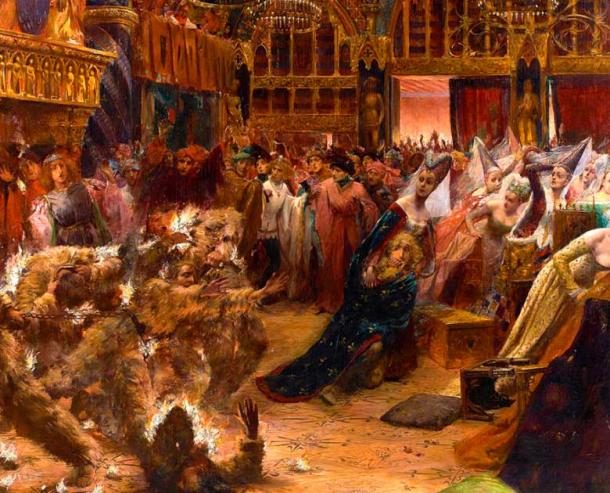
The Ball of the Burning Men, or le Bal des Ardents, is just one of many legendary parties which have gone down in history. This painting is by Georges Rochegrosse. Source: Public domain
Legendary Party #6. France Vs England at the Field of the Cloth of Gold
To say that France and England haven’t always gotten along would be a bit of an understatement. Both countries have spent the vast majority of their respective histories at war with each other. Even during the rare times of peace the two countries struggle to get along, hampered by a centuries-old rivalry.
The Field of the Cloth of Gold is an example of what has happened when France and England try to get along. The event was held in 1520 for 17 days from June 7th to June 24th. It was a rare period of peace and the two kingdom’s kings decided to celebrate with a massive party.
Of course in reality it was a chance for the two kings to try and outdo each other. The event took its name after the massive amount of expensive cloth both countries used to try to outshine each other. Huge tents were set up that housed huge banquets, jousting tournaments, and parties. Over 216,000 gallons of wine were drunk and 2,000 sheep were eaten.
The event was hugely expensive and turned out to be a waste of time, diplomatically speaking. Both kings had huge, sensitive egos that were out of control during the event. A highlight of the event was meant to be a wrestling match between King Henry VIII of England and King Francis I of France, but things are said to have gone sour after Henry’s defeat.

Representational image of a garden party, as depicted by Jan Sebastiaen Lobos in the 17th century. ( Public domain )
Legendary Party #7. Admiral Edward Russell’s Cocktail Party
The English have a reputation for enjoying a good drink and throughout history they have backed this reputation up with deeds. A classic example is Admiral Edward Russell’s cocktail party, held in the garden of his Covent Garden home in 1664.
Parties like this weren’t just about having a good time, they were about making a name for oneself. Russell decided the best way to show off was to have his garden’s fountain drained and refilled with 250 gallons of brandy, 125 gallons of Malaga wine, 1,400 lbs (635 kg) of sugar, 2,500 lemons, and 5 lbs (2.27 kg) of nutmeg. One very expensive and very big cocktail.
The legend goes that it took Russell’s guests an entire week to finish his record-breaking cocktail and that his party carried on the entire time. This being England, when it rained Russell had a silk canopy erected to ensure the alcohol wasn’t diluted (heaven forbid).

Oktoberfest celebrations as depicted by Alfred Schwarzschild. ( Public domain )
Legendary Party #8. The Original Oktoberfest
You know a party was really successful when it ended with everyone agreeing to do it all over again the following year. Oktoberfest as we know it today was originally held to celebrate the wedding of Bavarian Crown Prince Ludwig to Princess Therese of Sachsen-Hildurburghausen in Munich in 1810.
While royal weddings tend to be splendid affairs, this was a particularly big one and everyone in Bavaria was invited. For five days, starting on October 12th, 40,000 people from across Bavaria came to Munich to party.
It took months of preparations as restaurants tried to outdo each other with increasingly extravagant parties. More than 32,000 buns, 3,992 pounds (1,810 kg) of cheese, 900 pounds (408 kg) of mutton, and 13,000 pairs of sausages were devoured over the course of the party. Not to mention 23,000 liters of beer!
It was such a legendary party that everyone agreed to do it again the following year. This time however it was done on an even bigger scale, lasting for 12 days instead of the original five. Thus, the annual Oktoberfest, the world’s largest beer festival, was born.
The sheer scale of these historically legendary parties is truly astonishing and the level of preparation behind them migraine-inducing. It is true that our ancestors, especially the wealthy ones, really knew how to party. But has this changed all that much?
Throughout the 20th and 21st centuries, the world’s rich and famous have held parties that rival many on this list. Most of us are just never invited to them. Which probably isn’t such a a bad thing.





